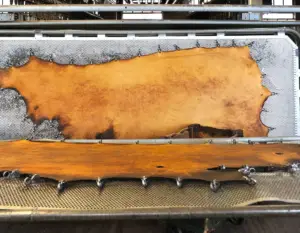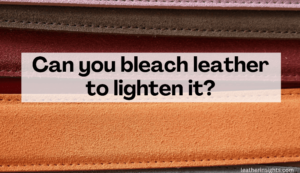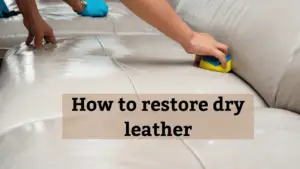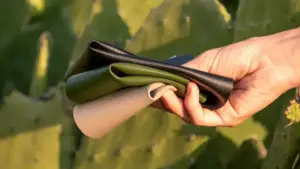How to Glue Leather to Plastic
Leather and plastic are two materials that can complement each other beautifully in a wide range of products. From bags to furniture, leather adds a touch of class and sophistication to any plastic surface.
However, when it comes to gluing leather to plastic, it’s crucial to choose the right adhesive to ensure a strong and lasting bond.
In this article, we will walk you through the step-by-step process of how to glue leather to plastic, providing tips and tricks to ensure a successful outcome.
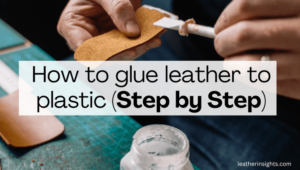
How to glue leather to plastic
To successfully glue leather to plastic, start by cleaning both surfaces and cutting the leather to size. Then, apply the adhesive evenly to both the leather and plastic surfaces. Carefully align the leather with the plastic and press firmly to ensure maximum contact. Trim any excess leather and allow the adhesive to dry completely. Finally, test the bond by gently pulling on the leather to ensure a strong, long-lasting bond.
Here’s the complete step-by-step guide for attaching the leather to plastic
Material needed:
- Leather
- Plastic
- An adhesive like cyanoacrylate or contact cement
- Clean cloth or brush
- Ruler or measuring tape
- Utility knife or scissors
Step 1: Clean and prepare the surfaces
The first step in gluing leather to plastic is to ensure both surfaces are clean and free of any dirt, oils, or debris.
Use a clean cloth or brush to remove any dust or dirt from the leather and plastic. If necessary, clean the surfaces with a mild soap solution and dry them thoroughly.
Step 2: Roughen the surfaces
Roughening the surface of the leather and plastic can help improve the adhesion of the glue and increase the bond strength.
This can be done using sandpaper to create a textured surface that allows the adhesive to grip the surfaces more effectively.
In addition, roughing up the surface will ensure a strong bond between the leather and plastic that will be less likely to come loose over time.
It’s important to clean the surfaces thoroughly after roughening to remove any debris or dust that could weaken the bond.
Step 3: Measure and cut the leather
Using a ruler or measuring tape, measure the plastic surface where the leather will be attached. Then cut the leather to size, allowing an extra 1/8 inch all around for trimming.
This step is important to ensure the leather fits the plastic surface properly and allows for enough adhesive to properly adhere the leather to the plastic.
Measuring accurately and cutting the leather with a little extra for trimming will result in a cleaner and more professional finish.
Step 4: Apply the adhesive
We have talked about the best adhesive for gluing leather to plastic that you should consider below.
So based on the type of adhesive you have chosen, follow the manufacturer’s instructions for application.
The adhesive is the key component to ensuring a strong and lasting bond between the leather and plastic.
It’s important that you carefully follow the manufacturer’s instructions when applying the adhesive to avoid any mistakes that could affect the bond strength.
Applying the adhesive evenly to both surfaces will also help you create a consistent and reliable bond.
Step 5: Attach the leather to the plastic
In this step, it’s important to carefully align the leather with the plastic and apply firm pressure to ensure maximum surface contact.
This will help ensure that the adhesive has maximum contact with both the leather and plastic surfaces, creating a stronger bond.
You can use a ruler or similar object to apply even pressure along the entire surface so as to eliminate any air pockets and create a uniform bond.
Step 6: Allow the adhesive to dry
Allowing the adhesive to dry completely is a crucial step in the process of gluing leather to plastic.
This is because skipping this step or not allowing enough time for the adhesive to dry can result in a weaker bond and could cause the leather to come loose from the plastic surface.
However, the drying time will vary depending on the type of adhesive used and the manufacturer’s instructions.
So it’s important to be patient and allow the adhesive to dry completely before moving to the next step or using your item.
Step 7: Trim the excess material
This is also an important step as trimming the excess leather will help to create a clean and professional finish.
Also, it will also help prevent the leather from fraying or unraveling over time.
The easiest way to do this is by using sharp scissors or a blade to carefully trim along the edges of the plastic surface to remove any extra leather. This step will give the final product a neat and finished appearance.
Step 8: Seal the bond if necessary
Sealing the leather and plastic surface can provide added protection and extend the life of the bond.
Depending on the type of adhesive used and the intended use of the leather-to-plastic item, a sealant may be recommended to protect the bond from moisture, UV rays, and other elements that could weaken the bond over time.
Some adhesives may already include a sealant, so be sure to check the manufacturer’s instructions before applying an additional sealant.
When using a sealant, note that it is also important to follow the manufacturer’s instructions for application and drying time to ensure the best results.
Step 9: Test the bond
Testing the bond is the final step in ensuring a successful outcome when gluing leather to plastic.
You can achieve this by gently pulling on the leather to get an idea of the bond strength and help you verify that the adhesive has properly adhered the leather to the plastic surface.
If the bond is strong, the project is complete and the leather-to-plastic item is ready to be used. But if the bond is weak, the adhesive may need to be reapplied or the leather may need to be trimmed differently to create a stronger bond.
What is the best glue for bonding leather to plastic
The best glue for bonding leather to plastic depends on the specific use case and the desired outcome.
Some common options include:
-
Contact cement
Contact cement is a popular choice for gluing leather to plastic as it creates a permanent bond that is both strong and flexible. It is particularly useful for applications that will be subject to wear and tear.
A good example of contact cement is Barge All-Purpose Cement which works effectively on leather, plastic, rubber, and vinyl. It can also be used to attach the leather to wood, metal, plaster, concrete, and paper.
Ideally, it is suitable for patching rubber boots and resoling leather shoes and boots due to its flexibility, strength, and durability.
Also, Barge contact cement is known for its resistance to water and extreme temperatures.
-
Epoxy resin
An epoxy resin such as this East Coast Resin is another option for gluing leather to plastic, and it’s known for its strong and durable bond.
It’s a two-part adhesive that requires mixing before application, and it takes longer to cure than other adhesives like contact cement.
However, once it has cured, the bond created by epoxy resin is very strong and resistant to moisture, heat, and chemicals, making it a good choice for items that will be exposed to harsh conditions.
-
Super glue
You can also use super glue to bond leather with plastic and particularly Gorilla Glue since it is polyurethane-based and forms a strong and durable bond.
One thing to keep in mind however is that Gorilla Glue expands as it cures, so it is important to apply it sparingly and only in the areas where bonding is needed.
Additionally, it takes longer to dry than other adhesives, so it may not be the best choice for projects that require a quick bonding solution.
Conclusion
To conclude, gluing leather to plastic can be accomplished using various adhesives, including super glue, epoxy, and contact cement.
Each type of adhesive has its own strengths and weaknesses, so it is important to choose the right one for your project based on its size, complexity, and desired end result.
Whether you are working on a small, simple project or a large, complex one, following the right steps and using the right tools will help ensure you get your desired results.
